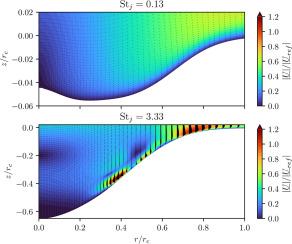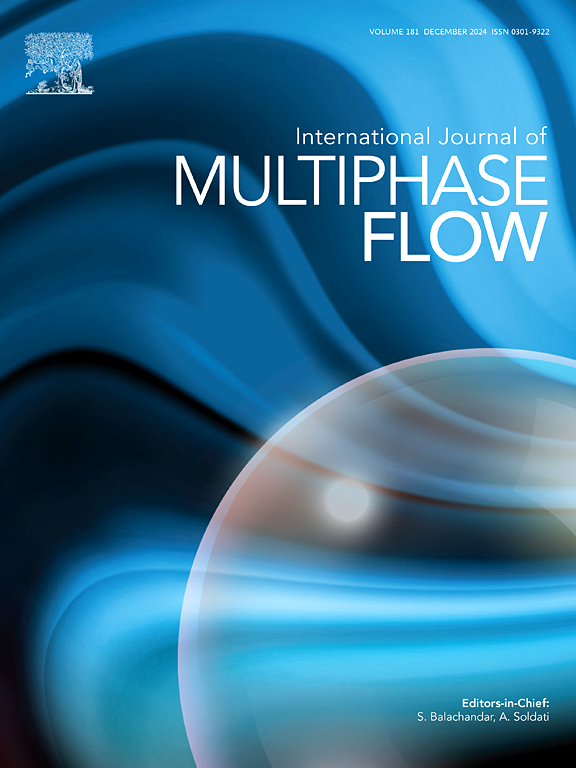用欧拉方法研究粒子撞击喷流引起的侵蚀
IF 3.6
2区 工程技术
Q1 MECHANICS
International Journal of Multiphase Flow
Pub Date : 2024-09-20
DOI:10.1016/j.ijmultiphaseflow.2024.105000
引用次数: 0
摘要
粒子的分散和侵蚀在各种工程应用中发挥着重要作用,尤其是在冲击射流中。本研究提出了一种新的欧拉方法,用于描述轴对称、层流和湍流射流撞击和瞬时侵蚀平壁时的这些现象。欧拉质量和动量守恒方程的求解假定流动与颗粒之间存在单向耦合。层流情况下的载流边界层速度剖面与分析解进行了验证。粒子计算包括入射粒子和反射粒子两个阶段,通过一个复原模型连接起来。反射粒子的计算结果有助于深入了解二次侵蚀区域,但不用于主要侵蚀计算。随后,利用经验侵蚀模型计算受侵蚀表面的侵蚀情况,然后利用线性弹性小应变变形方程计算计算节点的位移,所有这些都是瞬时求解。求解结果揭示了不同斯托克斯数下的空间粒子浓度和动量:较小的斯托克斯粒子沿载流子流线运动,中等斯托克斯粒子偏离,形成 W 形侵蚀剖面,而最大斯托克斯粒子则形成 U 形剖面。由于采用了欧拉方法,该数值模型为基于 CFD 的瞬态侵蚀计算提供了一个计算高效的框架。本文章由计算机程序翻译,如有差异,请以英文原文为准。

Eulerian approach for erosion induced by particle-laden impinging jets
Particle dispersion and erosion play an important role in various engineering applications, particularly in impinging jet flows. This study presents a new Eulerian method for characterizing these phenomena in axisymmetric, laminar, and turbulent jets, impinging and transiently eroding a flat wall. The Eulerian mass and momentum conservation equations are solved assuming a one-way coupling between the flow and the particles. The carrier flow boundary layer velocity profiles in the laminar case are validated with analytical solutions. The particle calculation involves two stages, incident and reflected particles, connected via a restitution model. The reflected particles’ results offer insights into secondary erosion areas but are not used for the main erosion calculations. Subsequently, erosion at the eroded surface is computed using an empirical erosion model, followed by the displacement of computational nodes using the linear-elastic, small-strain deformation equations, all of which are solved transiently. The solutions reveal the spatial particle concentrations and momentum for different Stokes numbers: smaller Stokes particles follow the carrier flow streamlines, medium Stokes particles deviate, forming a W-shaped erosion profile, while the largest Stokes particles create a U-shaped profile. This numerical model offers a computationally efficient framework for CFD-based transient erosion calculation due to its Eulerian implementation.
求助全文
通过发布文献求助,成功后即可免费获取论文全文。
去求助
来源期刊
CiteScore
7.30
自引率
10.50%
发文量
244
审稿时长
4 months
期刊介绍:
The International Journal of Multiphase Flow publishes analytical, numerical and experimental articles of lasting interest. The scope of the journal includes all aspects of mass, momentum and energy exchange phenomena among different phases such as occur in disperse flows, gas–liquid and liquid–liquid flows, flows in porous media, boiling, granular flows and others.
The journal publishes full papers, brief communications and conference announcements.

 求助内容:
求助内容: 应助结果提醒方式:
应助结果提醒方式:


